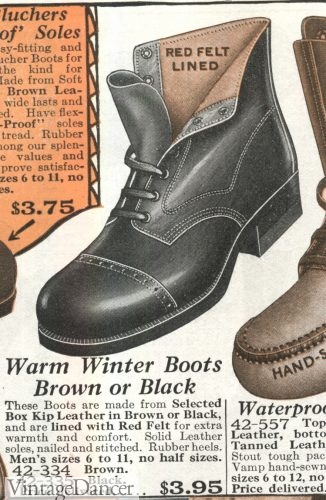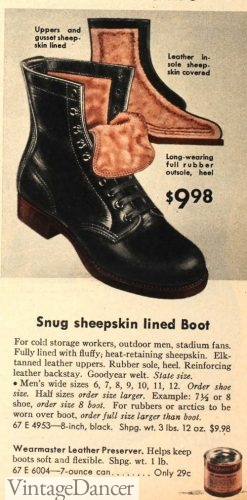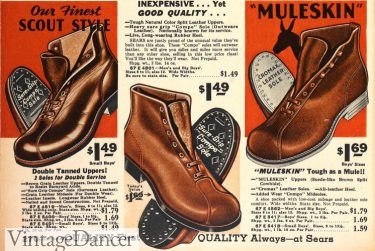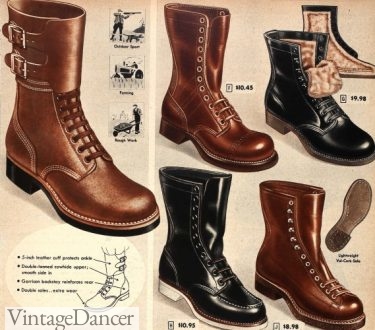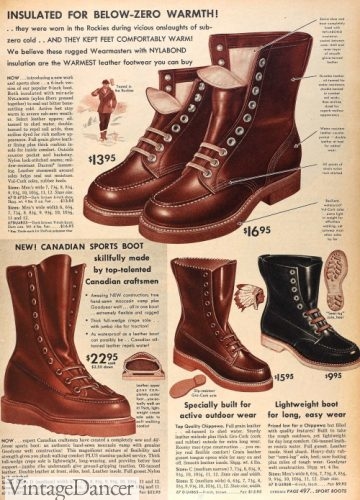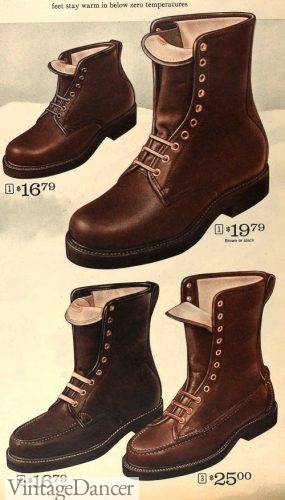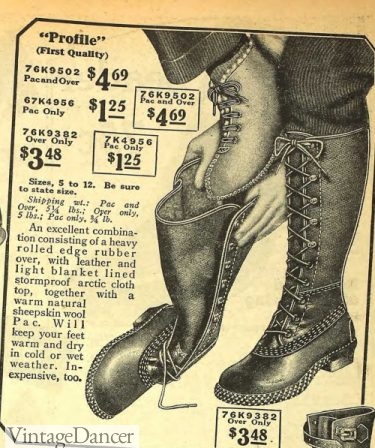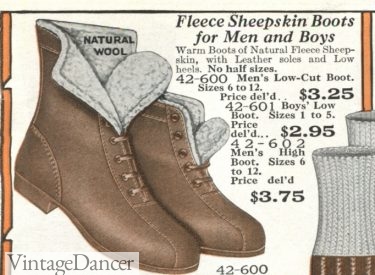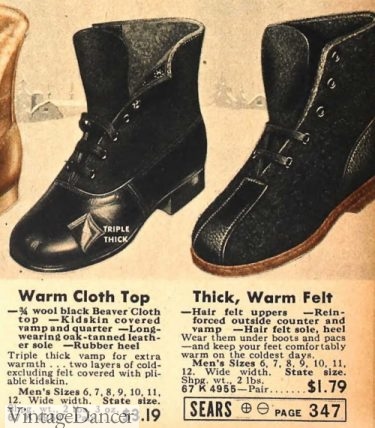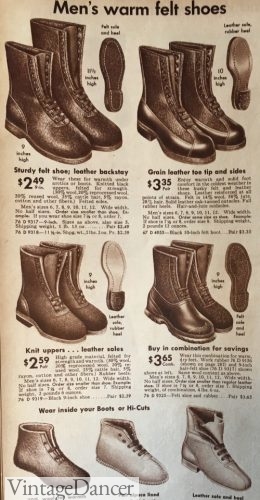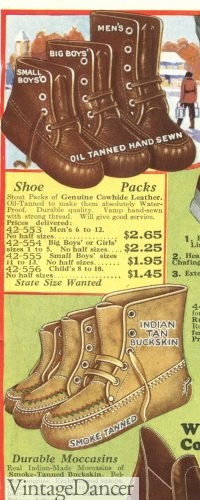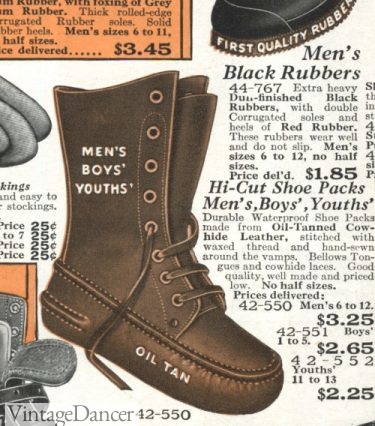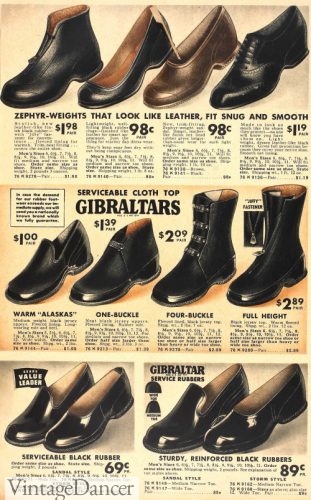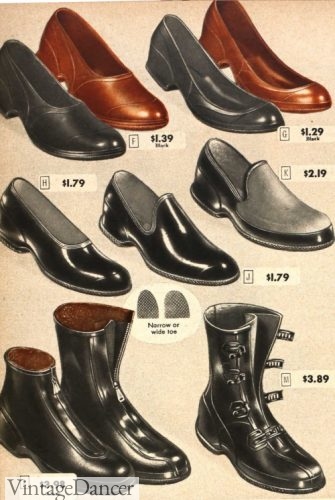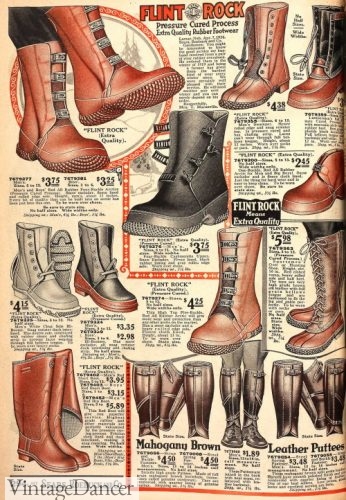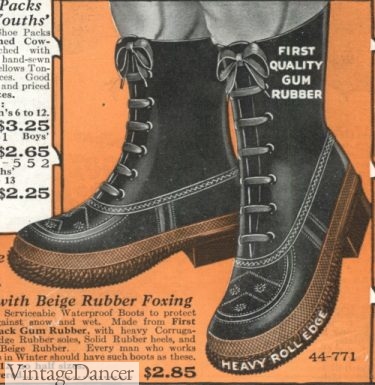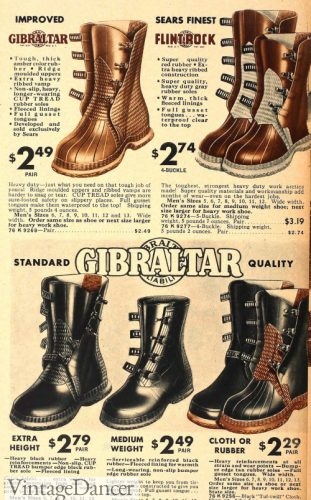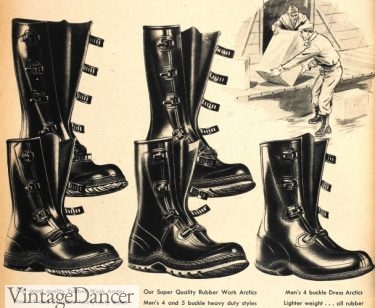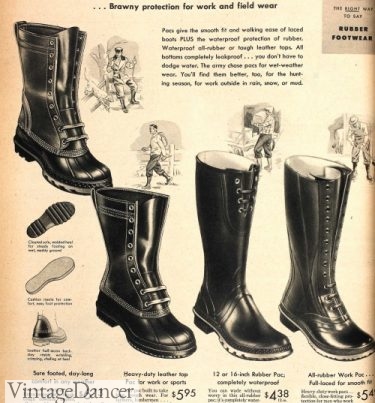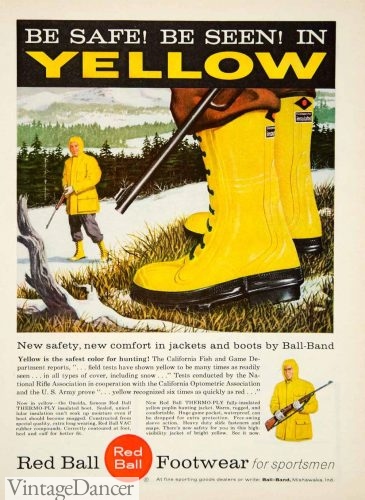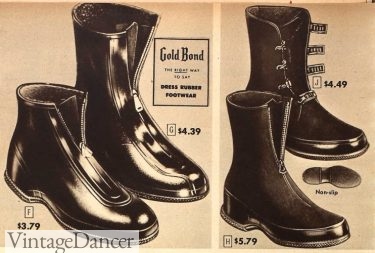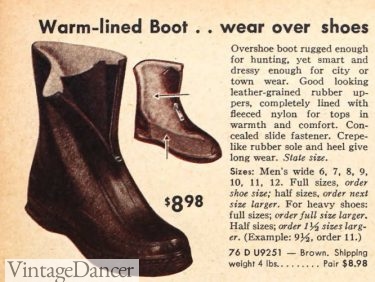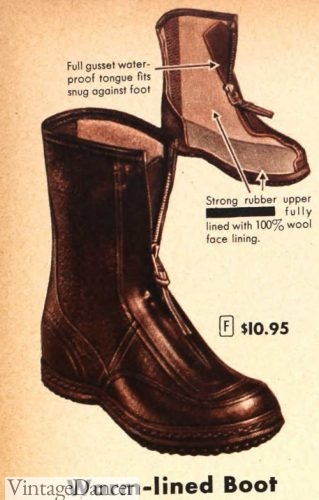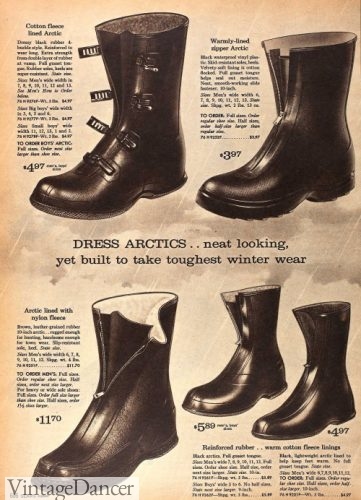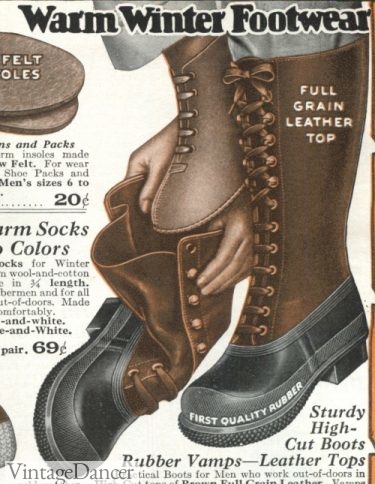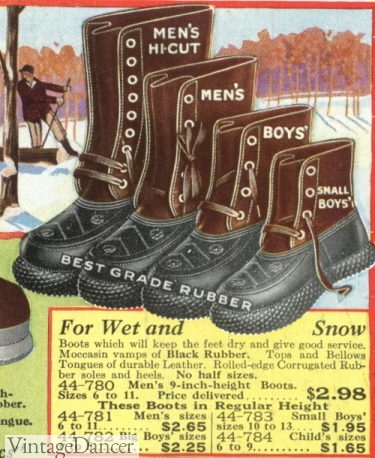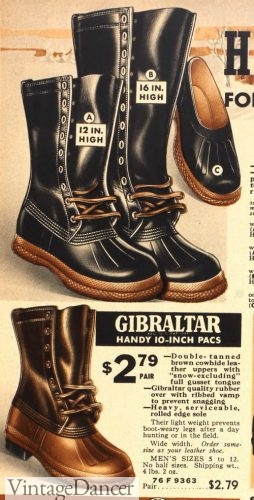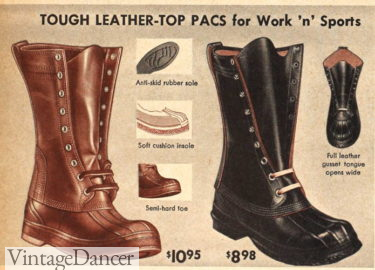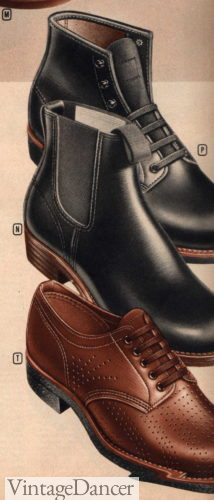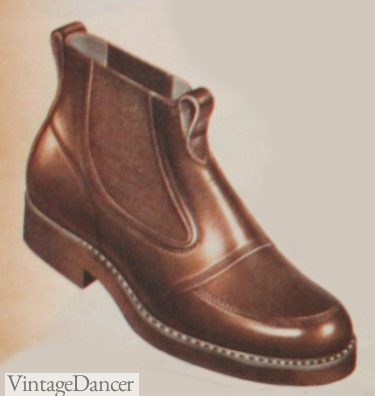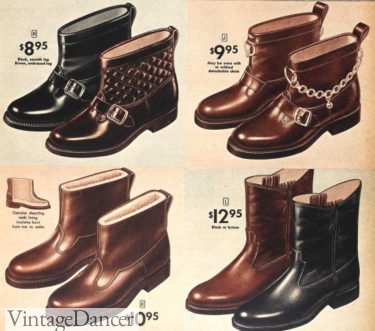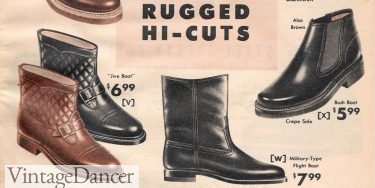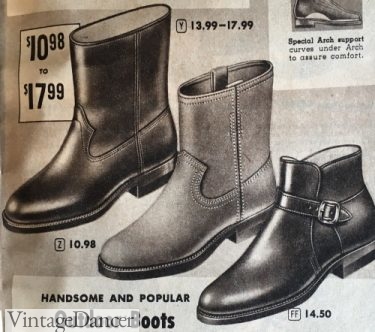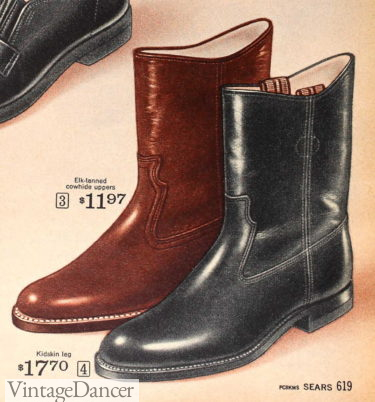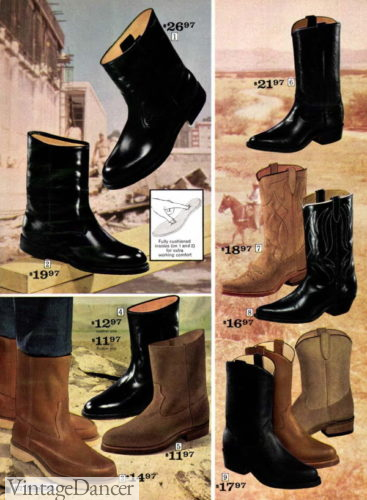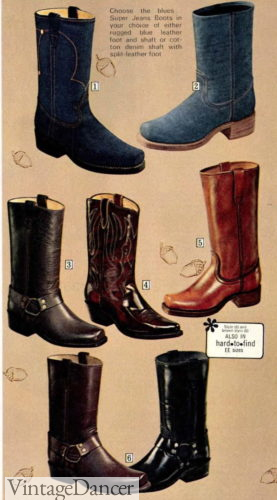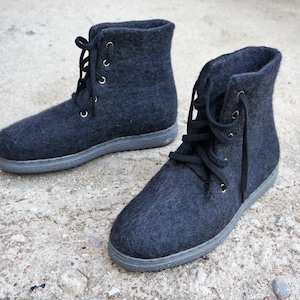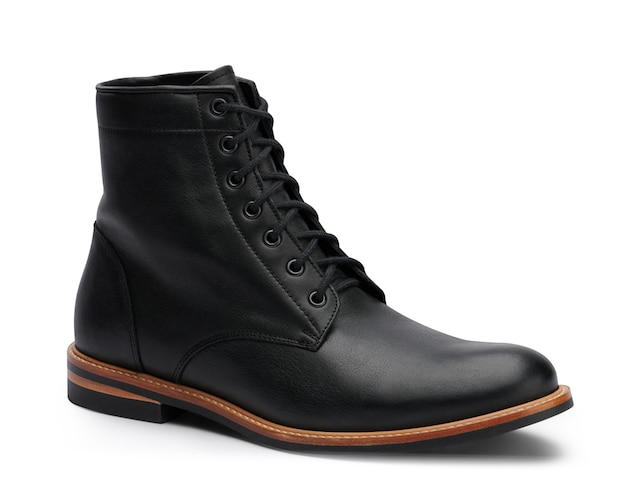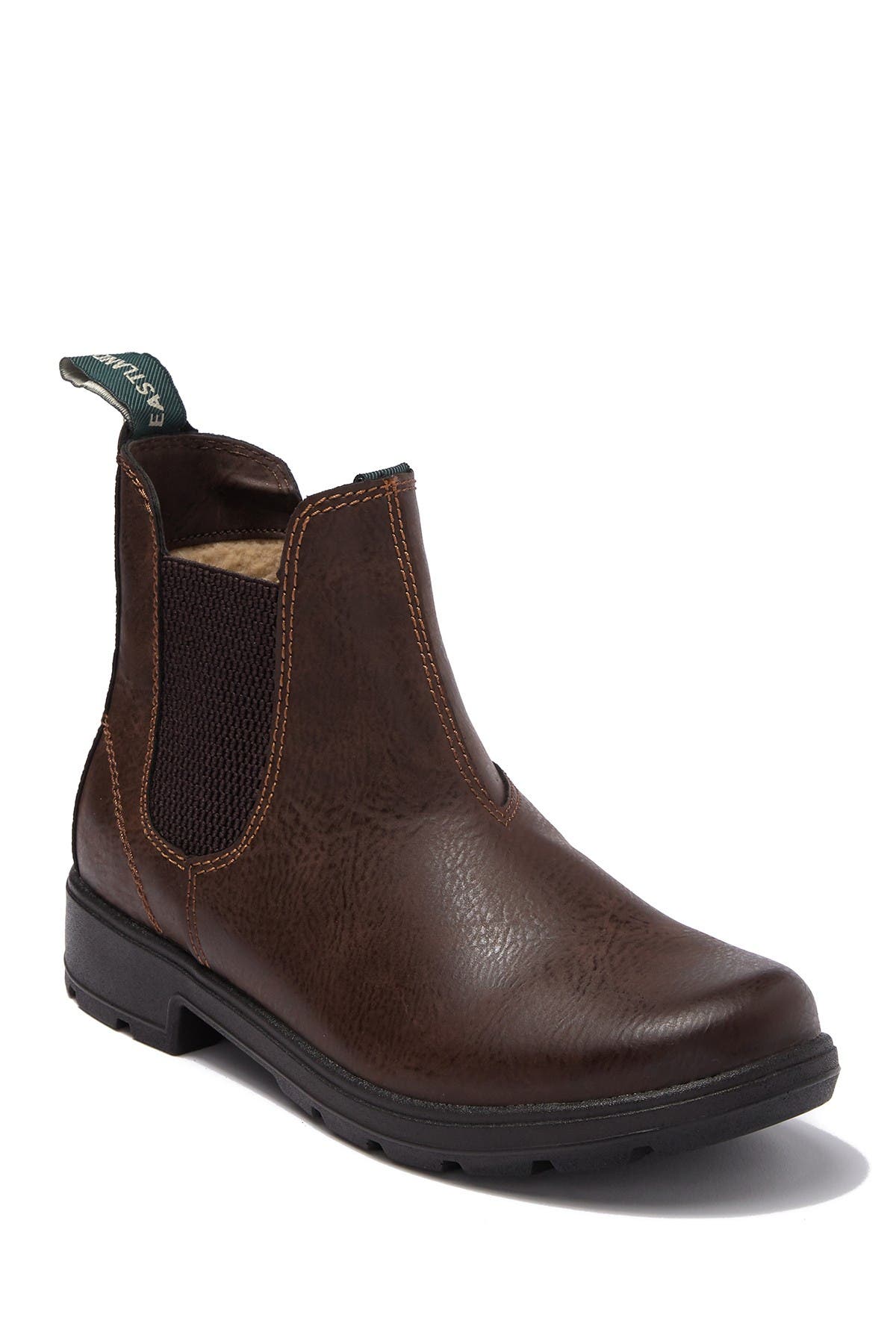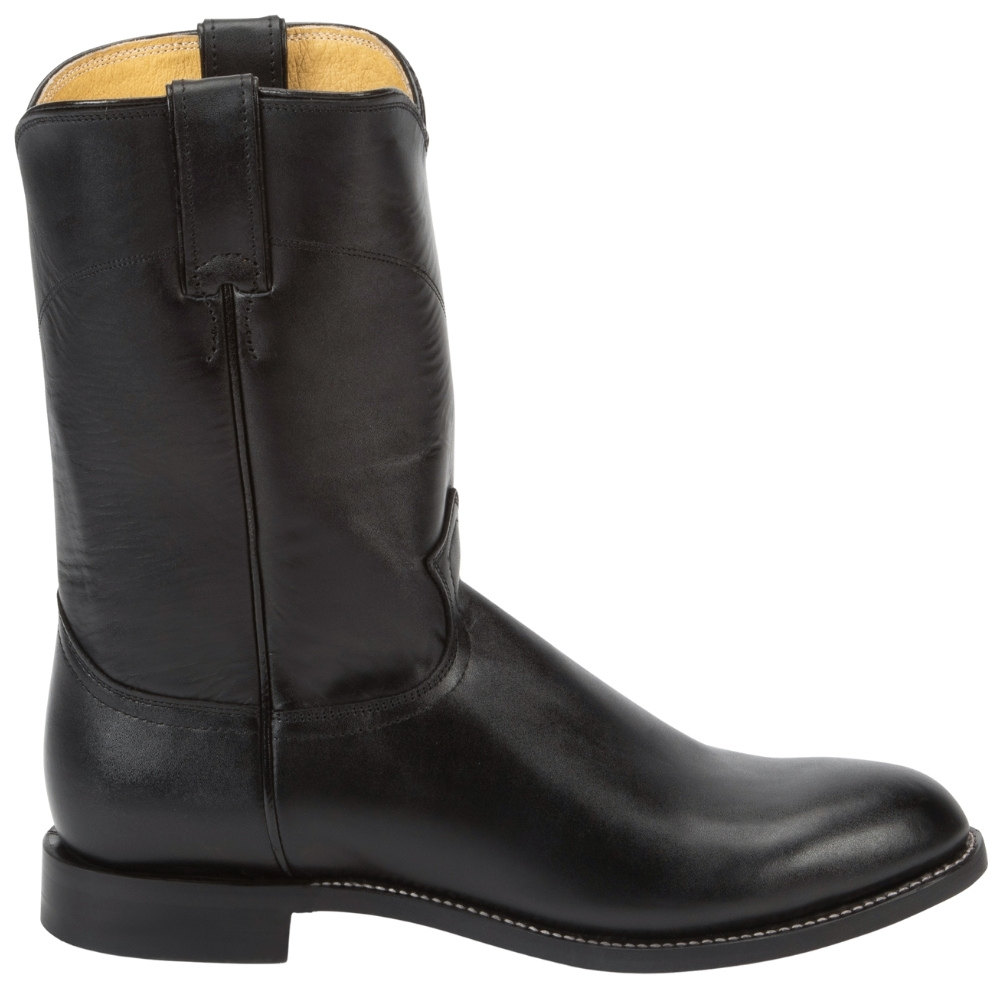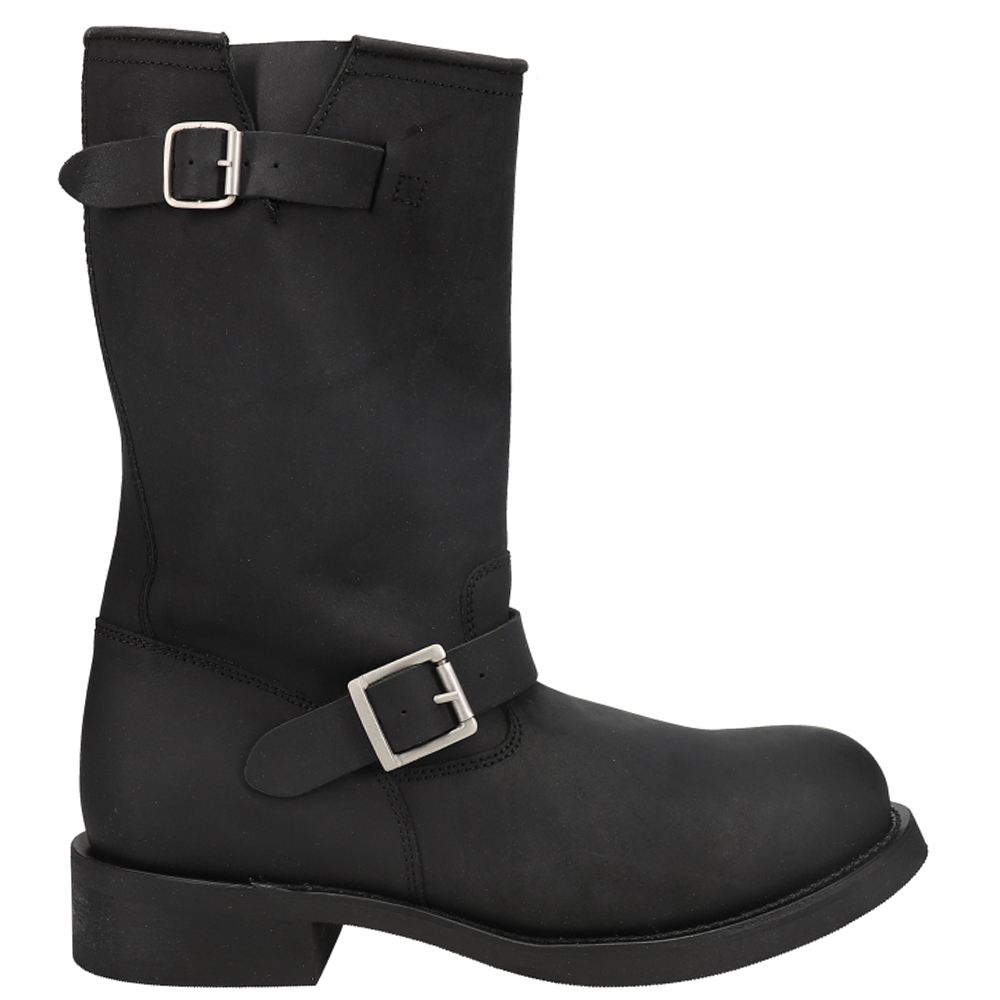A well dressed vintage gentlemen may experience a bit of a conundrum when it comes to winter footwear. What kind of shoes or boots can he wear when walking through snow, mud, rain or fighting the bitter cold and still look dapper? The answer lies in a variety of winter boots and rain shoes available in the 1920s, 1930s, 1940s, 1950s and 1960s.
Some men’s vintage boot styles are classics still available today (although not easy to find) while others have gone by the wayside of modern tech fabrics and hefty tread. Shopping links at the end to help you find vintage style boots available now.
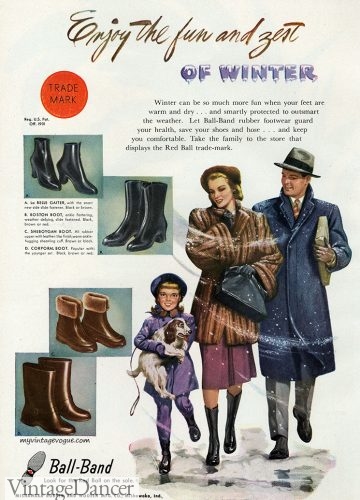
1947 Ball-Brand rain boots ads
Work Boots
For the working class man who wore lace up work boots everyday a pair of winter specific boots was usually unnecessary. Work boots were made of tough leather in brown or black with a moderate grooved tread of leather, rubber or cork. They could be plain toe, cap toe, scout or moccasin toe. They could rise just above the ankle, mid calf or over the calf, depending on occupational need and outfit.
Winter boots came lined in wool felt, blanket cloth, shearling or a second layer of leather. In the late 1950s synthetic cloth such as fleece mimicked the warmth and texture of wool.
Redwing and Wolverine make classic leather work boots but they are usually not lined. If you scale up one size and wear thick wool socks that may be enough.
- 1928 felt lined boots
- 1950 shearling lined work boots
- 1934 scout style winter work or sport boots
- 1949 winter work boots
- 1955 mens work boots
- 1962 men’s lined work boots
Tall lace up work boots were also worn for leisure sports like hiking and hunting. Even in winter the tall leather shaft protected legs from the elements. They were worn with jodphurs and breeches, never under long pants. If they were lined, it was with a thin felt or cloth. The warmth came with either shoe inserts and/or tall sport socks.
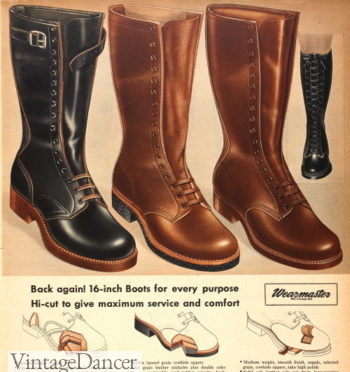
1946 tall work boots/ sport boots
Ski boots were specialty outdoor shoes with a medal shank, strap across the foot and soft sole. See some for sale at Vintage Winter
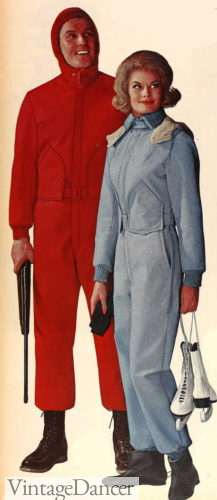
1962 ski outfits with lace up leather boots
Felt Boots and Inserts
Many men choose to purchase boots in a size larger so he could wear extra thick boot socks (which were only for the foot, ankle high) or boot inserts to stay warm. Insets came in felted wool or sheepskin with the wool on the inside. They looked like soft lace up booties with or without a heel. They were usually worn with boots but could also be worn with any kind of dress shoe, rain shoe, or alone as house slippers.
- 1927 wool inserts going into tall work or sport boots
- 1928 felt boot inserts
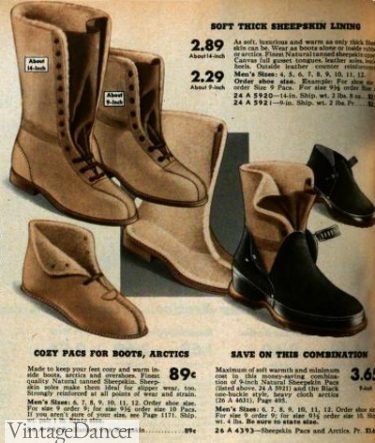
1941 sheepskin boot inserts
At the turn of the century, into the 1920s and again in the 1940s, the wool felt boot with leather or rubber sole was the best winter-specific boot. It was the warmest and durable against snow but not very good with rain. Snow boots had a felt sole while all-weather boots had a leather or rubber sole. Some were all felt boots while others combined leather on the foot or toeline with felt for the body.
Cheaper felt boots used horse or cow hair to create the felt. It was less durable but half the cost.
- 1938 felt boots
- 1944 felt boots and inserts
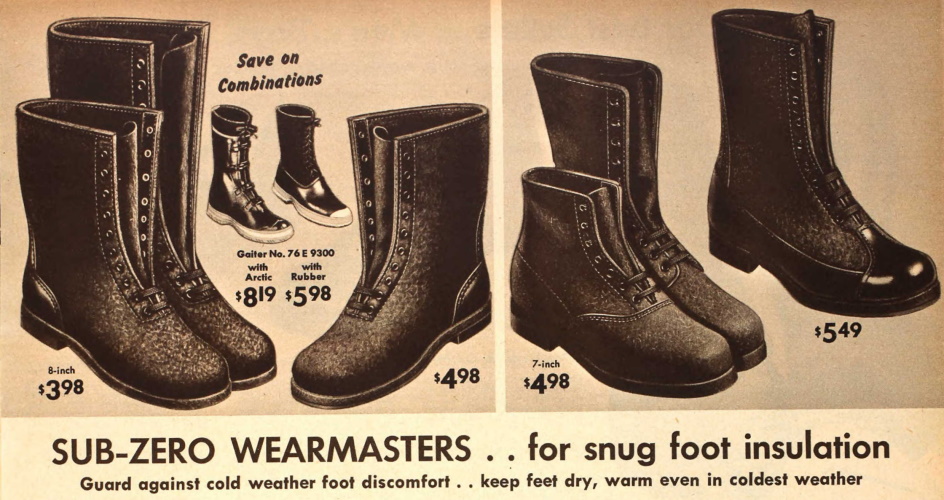
1950 felt boots
Snow Moccasins
The Shoepack boot was similar in design to the boot insert. It was made of oil tanned leather with a moccasin style bottom and an optional sole. The flexible nature of the boot made them ideal for heavy snow use, snowshoing, and as children’s winter shoes.
The moccasin boot was the same style but made of soft buckskin in a smoked tan process. They faded from winter footwear after the 1930s, except in extreme north locations.
- 1928 Oiled Leather Shoepac and Buckskin Moccasin
- 1928 snow-pac boots
Rain Shoes
Rain shoes were slip on rubber clog shoe that could be worn alone with socks or over dressy shoes such as oxfords. Rubber shoes were only useful in light rain. Some were lined but most were unlined. At the turn of the century they came in several toe shapes.1 Regular toe 2. Broad toe (round) 3. Piccadilly (pointed toe)
By the late 1930s the plain shiny rubber was diversified with a leather-look rubber. Rubber was also molded into the design of dress shoes complete with broguing, wingtips, foxing, and faux laces.
- 1938 rubber rain shoes
- 1948 mens rain shoes and boots
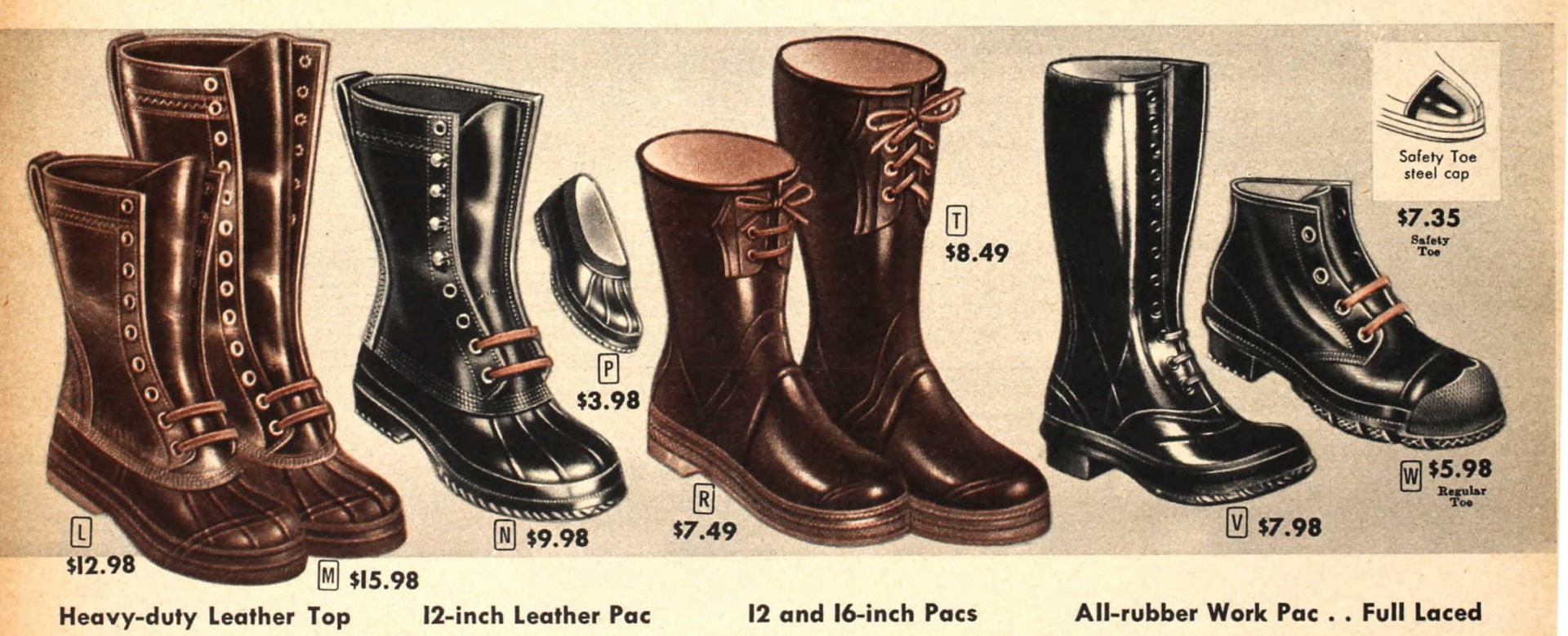
1951 men’s rain boots
Rain Boots- Arctics
The Arctic boot later called Galoshes or gaiters was an all rubber or rubber shoe and wool felt shaft boot with a shearling lining. Men wore these boots for all winter weather rain and snow. Some had a bellows fold to protect snow from ending up in-between the buckles.
Buckles were 3-4 for tall boots or only 1 for the ankle bootie style. Most boots were all black until the red rubber boot became fashionable around 1915. Brown rubber boots or a mix of brown and black rubber remained in style until 1960s when brighter colors were trendy with hunters or mod men.
Eventually zippers replaced buckles and laces coated in wax were acceptable too.
- 1924 mens red rubber boots
- 1928 all rubber boots
- 1938 Gibraltar artics
- 1946 men’s rubber buckle boots
- 1946 rubber boots- buckle and pullon/laced
- 1959 yellow “hunters” rubber boots
Blizzard Boots
For snow and rain boots for city folks and light snow pile areas the blizzard boot emerged in the late 1940s. Rubber or felt/rubber mixed outers with shearling or wool cloth lining and a zip up front closure it was the most popular boot worn with suits. Some had a wide toes, others narrow toes for a dressier look. Most were “overshoes” meaning men slipped their shoed foot into the boot.
- 1950 zip up rubber boots
- 1955 fleece lined zip boots
- 1951 brown zip front rubber boots
- 1962 mens rubber boots with zip
In the late 50s a new flexible rubber boot was borrowed from South America. It could be stepped-in and rolled up to the calf, making quick changes a breeze. It could also be folded down and placed in a bag for easy carrying too.
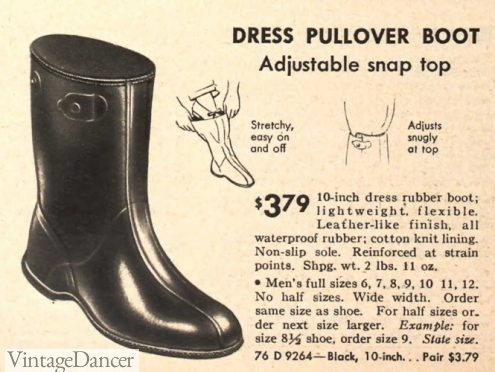
1948 rolldown flexible rubber boots
Duck Boots
If there was a perfect boot that crossed the bridge between snow and rain use it would be the Duck boot. Originally created by LL Bean in 1918, the Maine Hunting Boot or Bean Boot, was designed with a rubber foot and a leather shaft. It provided the best of both weather-proof boot types into one.
The Bean Boot was quickly copied by other brands and made with felt or canvas tops and rubber shoes in black, red or natural. The casual look of the boot made them popular as workwear and outdoor sport boots. The duck boot experienced a revival in the early 1980s as well as currently.
- 1928 black rubber foot, tall leather shaft
- 1928 Duck Boots
- 1937 black and red rubber sole, black leather shaft
- 1955 duck boots
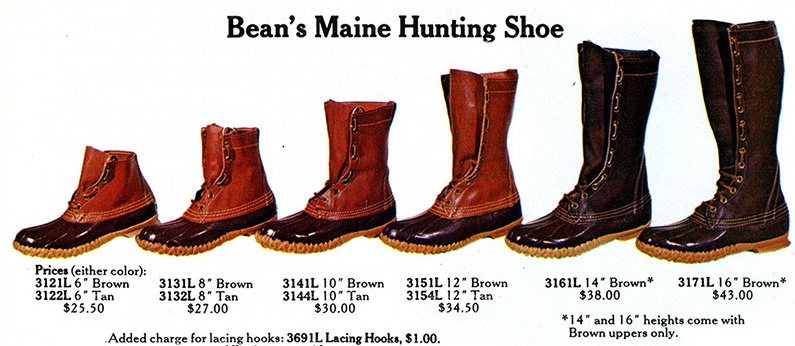
1977 LL Bean Maine Hunting Boots aka Bean Boots or Duck Boots
Pull On Boots / Slip On Boots
Chelsea boots with an elastic panel on either side of the shaft were the original pull on boot. They were considered a dress boot in the early teens and twenties, usually for older men who could not bend down to tie laces.
By the 1940s were came back as a functional dress or winter boot. While not terribly popular the style remained into the 1950s and 1960s. They are back in fashion now and readily found in stores.
- 1947 Chelsea boots (middle)
- 1955 Chelsea Boots
In the 1950s the step-in or pull on boot, especially with a short shaft made way into the fashion arena, even in warmer weather. Some looked like engineer boots, others western boots. The Wellington style boot with its minimal design was the most enduring, well into the 1960s. Winter boots were lined in thin fleece, thick wool shearling, or nylon with a natural leather or high-shine exterior.
With more buildings having central heat the need for a heavy rubber boot in the city was no longer. These short, mid-calf or tall wellington boots remained city men’s preferred winter boot well into the 1970s and 80s.
- 1953 wellington boots- plain and quilted
- 1957 workwear short boots and chelsea boot
- 1959 outdoor short boots
- 1963 Wellington dress boots
- 1969 Pull on western and Wellington boots
- 1975 pull on boots
Blundstone- Has a nice selection of pull on Chelsea boots for women and men. Many are waterproof and they also have some lace ups with faux fur lining.
Men’s Vintage Winter Boots for You
All of these types of men’s winter boots would be excellent choices for your vintage outfits. Some are more casual or rugged while the slim-line styles would pair better with suits and dress clothes. The tricky part is finding them. Few modern shoe makers re-make winter boots. Even fewer offer warm wool lining. Sometimes your only option is to go with modern boots- and that’s ok.
These boots are ones I have found (mostly in the USA) that have the look of vintage winter boots but are made new:
Debbie Sessions has been teaching fashion history and helping people dress for vintage themed events since 2009. She has turned a hobby into VintageDancer.com with hundreds of well researched articles and hand picked links to vintage inspired clothing online. She aims to make dressing accurately (or not) an affordable option for all. Oh, and she dances too.
